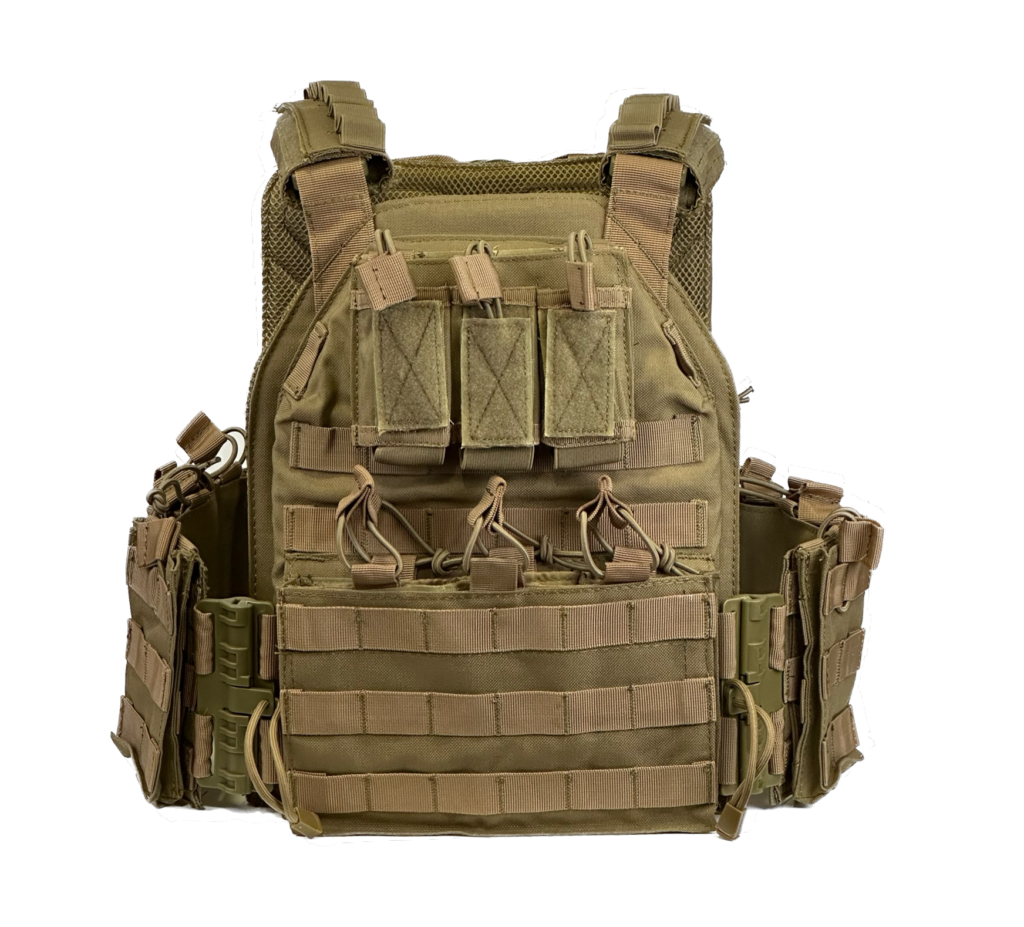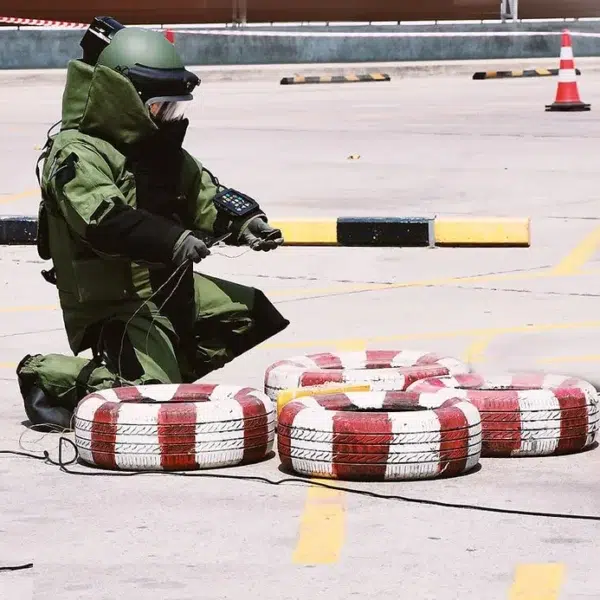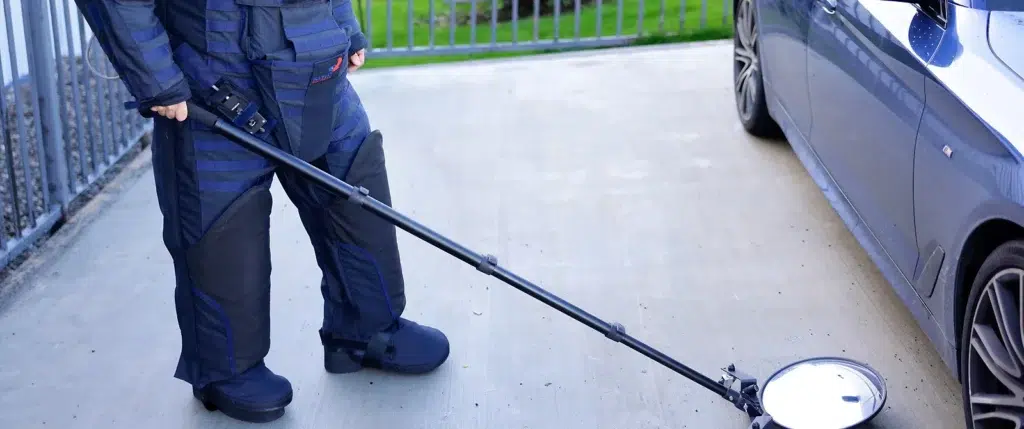Our Full Guide to Protective Armor
The importance of advanced protective gear cannot be overstated. For military personnel and special forces operating in high-risk environments, having reliable body armor and protective equipment can make all the difference between safety and injury.
At Sarkar Tactical, we understand the critical nature of dangerous environments. We take great pride in crafting bespoke, premium, and technical protective armor.
In this comprehensive guide, we will explore the intricacies of protective armor. From the different types and uses they have, to the technologies that shape its development today.
Table of Contents
What are the Different Types of Protective Armor Used?

There are a lot of different types of protective armor available and used by different militaries. From plate carriers to ballistic vests, each piece of armor is used for different purposes.
Below, we take a look at the main types of modern protective armor used in military and security operations:
Plate Carriers

Plate carriers play a pivotal role in safeguarding military personnel. They offer a versatile solution for confronting ballistic threats effectively.
Purpose and Design:
Their primary purpose is to hold and secure ballistic plates, which offer added protection against ballistic threats, such as bullets and projectiles. These carriers are engineered to distribute the weight of the plates evenly across the wearer’s torso, ensuring comfort and mobility during operations. Plate carriers are characterized by their modular design, featuring webbing, MOLLE (Modular Lightweight Load-carrying Equipment), or PALS (Pouch Attachment Ladder System) loops, allowing users to attach various accessories, pouches, and equipment as needed.
This versatility enables personnel to tailor their loadout according to the specific requirements of each operation. Plate carriers are an indispensable part of any tactical ensemble.
When They Are Used:
Plate carriers are commonly used in a variety of military operations where the risk of ballistic threats is high. These include, but are not limited to:
-
- Combat Operations
-
- Armed police operations
-
- Security Details
-
- Peacekeeping Missions
Popularity and Advantages:
Plate carriers have gained immense popularity due to several key advantages they offer. They are customizable, allowing users to configure a specific loadout to the needs of an operation. As they hold ballistic plates, plate carriers provide an efficient level of ballistic protection. As plate carriers are also designed to maintain the wearer’s freedom of movement, they are often chosen for operations due to the ease of movement they offer.
Learn more:
Ballistic Vests

Ballistic vests, commonly known as bulletproof vests, stand as a critical line of defense against a wide array of ballistic threats faced by military personnel, police officers, and security professionals.
Purpose and Design:
The primary purpose of ballistic vests is to absorb and dissipate the energy from projectiles, such as bullets and shrapnel. They are designed to provide protection to vital areas of the body, including the chest, back, and sometimes the sides. Ballistic vests typically consist of multiple layers of strong and flexible materials, such as Kevlar. These layers work in tandem to slow down and deform projectiles. They dissipate kinetic energy and prevent them from penetrating the wearer’s body.
When They Are Used:
Ballistic vests are deployed in a variety of scenarios where there is a risk of ballistic threats, including:
-
- Military Combat
-
- Police Patrols and Operations
-
- Security Details
-
- Press Protection
Popularity and Advantages:
Ballistic vests have become widely adopted due to their numerous advantages. These vests offer adaptable protection, making them suitable for a range of scenarios. Ballistic vests are generally considered lightweight compared to some armor options. Some ballistic vests can also be worn covertly, making them ideal for undercover police officers.
Find out more about what ballistic vests are made out of.
Patrol Vests

Patrol vests serve as an indispensable layer of protection. They are worn by police officers, security personnel, and others facing the potential risk of edged weapon attacks.
Purpose and Design:
Patrol vests are a specialized type of protective gear. They are designed to defend against puncture and slashing attacks from edged weapons such as knives, blades, and other sharp objects. Patrol vests are constructed with a unique combination of materials designed to resist and disperse the force of a stabbing motion, significantly reducing the risk of injury.
The key feature of patrol vests is the use of multiple layers of tough, puncture-resistant materials, such as laminated Kevlar or other high-strength fabrics. These layers are strategically arranged to withstand penetration and distribute the force of a stabbing motion across a wider area. This can minimize the chance of critical injury.
When They Are Used:
Patrol vests are essential protective gear in scenarios where encounters with edged weapons are a potential risk. Common roles where patrol vests are utilised include:
-
- Police Officers
-
- Security Roles
-
- Prison Environments
Popularity and Advantages:
Patrol vests have gained popularity due to their unique advantages in defending against edged threats. Patrol vests offer dedicated defence against puncture and slashing attacks, providing wearers with the confidence to confront close-quarters danger. They are also designed to be flexible and lightweight. Some stab vests are also discreetly designed for concealment underneath clothing.
Ballistic Helmets

Ballistic helmets are an integral part of protective gear. They are designed to provide paramount defense to the head.
Purpose and Design:
These helmets are engineered to shield wearers from ballistic threats. This includes bullets and low-velocity impacts, while maintaining optimal comfort and functionality. The design of ballistic helmets varies depending on the intended application, with a focus on lightweight construction without compromising on protective capabilities.
Most ballistic helmets consist of a hard outer shell made from materials like aramid fibers or ballistic composites. The inner lining typically includes padding or suspension systems that absorb and disperse the impact force. This can help minimize trauma to the wearer’s head.
When They Are Used:
Ballistic helmets find application in a wide range of military and armed operations, where protection of the head is essential. These scenarios include:
-
- Military Combat
-
- Armed Police Operations
-
- Special Forces Missions
-
- Close Protection Details
Popularity and Advantages:
The popularity of ballistic helmets is driven by several key advantages. Ballistic helmets provide crucial protection to the head, safeguarding against ballistic threats. This can potentially be life-saving in dangerous situations. Advanced materials and design techniques have resulted in lightweight ballistic helmets, ensuring wearers can operate effectively without discomfort or fatigue. Ballistic helmets can be designed to accommodate various accessories, such as night vision devices, communication systems, and helmet-mounted cameras.
Learn more about what ballistic helmets are made of and their key features.
Tactical Gloves

Tactical gloves are a piece of protective gear designed to safeguard the hands of armed personnel.
Purpose and Design:
These gloves serve many purposes. Providing not only protection but also enhancing dexterity and grip, they enable wearers to perform intricate tasks with precision and confidence. The design of tactical gloves is optimized for flexibility and durability. They are constructed with a combination of synthetic materials, such as synthetic leather, Kevlar, or Nomex. The incorporation of protective padding and impact-resistant features shields the hands from potential injuries. This makes these gloves ideal for diverse operational environments.
When They Are Used:
Tactical gloves find application in a wide range of tactical and outdoor situations, including:
-
- Military Operations
-
- Shooting Sports
-
- Outdoor Activities
Popularity and Advantages:
The reinforced construction of tactical gloves shields hands from cuts, abrasions, and impacts, reducing the risk of injury in hazardous environments. The textured palm surfaces also offer an improved grip, allowing wearers to handle weapons, tools, and equipment with precision and control.
Bomb Suits

Bomb suits are also known as EOD (Explosive Ordnance Disposal) suits. They are specialized protective garments designed to safeguard bomb disposal technicians from the risks posed by explosive devices.
Purpose and Design:
These suits serve as the frontline defense against potential blasts, fragmentation, and heat generated by explosive materials. The design of bomb suits prioritizes maximum protection while providing mobility and comfort, enabling them to perform delicate and hazardous tasks with confidence.
Bomb suits typically consist of multiple layers of materials, including aramid fibers and ballistic composites. These layers are complemented by padding and shock-absorbing elements strategically positioned to disperse the impact force generated by explosions.
When They Are Used:
Bomb suits are utilized in a variety of scenarios where there is a need to disarm, neutralize, or remove explosive devices. This includes:
-
- Police and Military Counter-Terrorism
-
- Protection for VIPs
Popularity and Advantages:
Bomb suits have gained prominence due to their advantages in explosive threat mitigation. Bomb suits offer a comprehensive defense against blast overpressure, fragmentation, and heat generated by explosive materials, significantly reducing the risk of injury.
Learn more about how much a bomb suit weighs and their key features.
Demining Suits

Demining suits are specialized protective garments. They are designed to shield demining personnel from the risks associated with explosive remnants of war (ERW) and landmines.
Purpose and Design:
These suits are critical tools in humanitarian efforts to clear landmines and unexploded ordnances. They help in ensuring the safety of deminers as they work to make affected areas safe for civilian populations. Demining suits feature multiple layers of durable and resilient materials, including ballistic composites, aramid fibers, and specialized padding. These layers are strategically positioned to absorb and disperse the impact of potential explosions, safeguarding the wearer against blast overpressure, fragmentation, and shrapnel.
When They Are Used:
Demining suits are used in a range of humanitarian and military scenarios where deminers engage in the clearance of landmines and explosive remnants of war, including:
-
- Humanitarian Demining
-
- Military Clearance Operations
-
- Clearance of ERW and IEDs
Popularity and Advantages:
Demining suits offer life-saving protection, drastically reducing the risk of injury faced by demining personnel. Despite their protective layers, demining suits are designed to permit deminers to move with relative ease and precision. This allows them to delicately clear areas of explosive threats. Demining suits also incorporate ergonomic features to ensure comfort during extended demining operations, enabling deminers to maintain focus and concentration.
Protective Armor at Sarkar Tactical
When it comes to safeguarding lives, compromise is not an option. Equip yourself with the finest protective gear the industry has to offer. At Sarkar Tactical, our bespoke, premium, and technical body armor is crafted to meet the rigorous demands of military personnel and special forces worldwide.
Visit our protective armor range today. From custom-fit solutions to innovative materials, we ensure our commitment to safety is followed.
Join the ranks who trust Sarkar Tactical to protect them in the most challenging environments. Contact us for more information, or view the rest of our blog section to learn more from our expert team. If you want to learn more about the important equipment we sell, have a look at our full guide to tactical gear.


